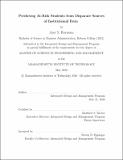| dc.contributor.author | Rayasam, Ajay S.
(Ajay Siva) | en_US |
| dc.contributor.other | Massachusetts Institute of Technology. Integrated Design and Management Program. | en_US |
| dc.contributor.other | Massachusetts Institute of Technology. Engineering and Management Program. | en_US |
| dc.contributor.other | System Design and Management Program. | en_US |
| dc.date.accessioned | 2021-10-08T16:59:39Z | |
| dc.date.available | 2021-10-08T16:59:39Z | |
| dc.date.copyright | 2020 | en_US |
| dc.date.issued | 2020 | en_US |
| dc.identifier.uri | https://hdl.handle.net/1721.1/132861 | |
| dc.description | Thesis: S.M. in Engineering and Management, Massachusetts Institute of Technology, System Design and Management Program, May, 2020 | en_US |
| dc.description | Cataloged from the official version of thesis. | en_US |
| dc.description | Includes bibliographical references (pages 65-68). | en_US |
| dc.description.abstract | In the past few years, the Mental Health Crisis in Higher Education has captivated the nation. This may be due in part to high profile cases, shifts in cultural attitudes, or increased demand for treatment. Regardless of the cause, student mental health has now become an epidemic. At MIT, there are over 4,000 consultations, 200 wellbeing checks and 50-70 psychiatric hospitalizations annually. In order to combat this challenge, most institutions invest in services such as mental health counseling or emergency response teams. However, these services are primarily used for students who self-report symptoms or for extreme cases. Unfortunately, of the nearly 3 million college dropouts per year, more than 40% did not report their mental illness. While the institutions have promoted mental health awareness, many students, who suffer from mental illness, remain undiscovered. As a result, this thesis proposes an novel approach -- using artificial intelligence to identify those hidden students. By leveraging non-invasive data found within the institution, machine learning can predict at-risk students before any symptoms occur. By doing so, the institutions could prevent dropouts, leaves of absences and deaths due to mental illness. | en_US |
| dc.description.statementofresponsibility | by Ajay S. Rayasam. | en_US |
| dc.format.extent | 68 pages | en_US |
| dc.language.iso | eng | en_US |
| dc.publisher | Massachusetts Institute of Technology | en_US |
| dc.rights | MIT theses may be protected by copyright. Please reuse MIT thesis content according to the MIT Libraries Permissions Policy, which is available through the URL provided. | en_US |
| dc.rights.uri | http://dspace.mit.edu/handle/1721.1/7582 | en_US |
| dc.subject | Integrated Design and Management Program. | en_US |
| dc.subject | Engineering and Management Program. | en_US |
| dc.subject | System Design and Management Program. | en_US |
| dc.title | Predicting at-risk students from disparate sources of institutional data | en_US |
| dc.type | Thesis | en_US |
| dc.description.degree | S.M. in Engineering and Management | en_US |
| dc.contributor.department | Massachusetts Institute of Technology. Integrated Design and Management Program | en_US |
| dc.contributor.department | Massachusetts Institute of Technology. Engineering and Management Program | en_US |
| dc.identifier.oclc | 1263245532 | en_US |
| dc.description.collection | S.M.inEngineeringandManagement Massachusetts Institute of Technology, System Design and Management Program | en_US |
| dspace.imported | 2021-10-08T16:59:39Z | en_US |
| mit.thesis.degree | Master | en_US |
| mit.thesis.department | SysDes | en_US |
